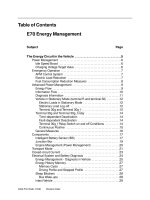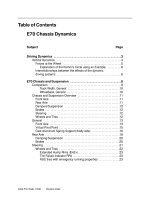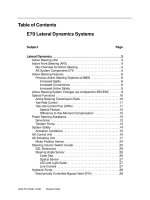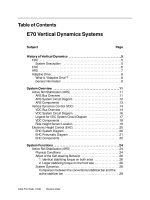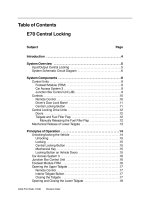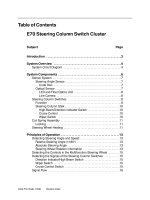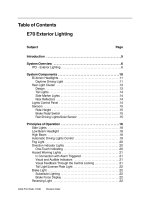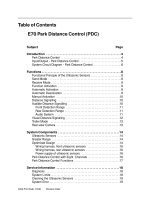Xe ô tô BMW X5 E70 SM 04a_E70 Chassis Dynamics
Bạn đang xem bản rút gọn của tài liệu. Xem và tải ngay bản đầy đủ của tài liệu tại đây (415.05 KB, 23 trang )
Initial P
rint
Dat
e: 10/06
Table of Contents
Subject Page
Driving Dynamics . . . . . . . . . . . . . . . . . . . . . . . . . . . . . . . . . . . . . . . . . . . . .3
Vertical Dynamics . . . . . . . . . . . . . . . . . . . . . . . . . . . . . . . . . . . . . . . . . . . . . . .4
Forces at the Wheel . . . . . . . . . . . . . . . . . . . . . . . . . . . . . . . . . . . . . . . . . .5
Explanation of the Kamm's Circle using an Example . . . . . . . . . . .6
Interrelationships between the effects of the dynamic
driving systems . . . . . . . . . . . . . . . . . . . . . . . . . . . . . . . . . . . . . . . . . . . . . .6
E70 Chassis and Suspension . . . . . . . . . . . . . . . . . . . . . . . . . . . . . . . . . .8
Comparison . . . . . . . . . . . . . . . . . . . . . . . . . . . . . . . . . . . . . . . . . . . . . . . . . . . .9
Track Width, General . . . . . . . . . . . . . . . . . . . . . . . . . . . . . . . . . . . . .10
Wheelbase, General . . . . . . . . . . . . . . . . . . . . . . . . . . . . . . . . . . . . . .10
Chassis and Suspension Overview . . . . . . . . . . . . . . . . . . . . . . . . . . . . . .11
Front Axle . . . . . . . . . . . . . . . . . . . . . . . . . . . . . . . . . . . . . . . . . . . . . . . . . .11
Rear Axle . . . . . . . . . . . . . . . . . . . . . . . . . . . . . . . . . . . . . . . . . . . . . . . . . .11
Dampers/Suspension . . . . . . . . . . . . . . . . . . . . . . . . . . . . . . . . . . . . . . .12
Brakes . . . . . . . . . . . . . . . . . . . . . . . . . . . . . . . . . . . . . . . . . . . . . . . . . . . . .12
Steering . . . . . . . . . . . . . . . . . . . . . . . . . . . . . . . . . . . . . . . . . . . . . . . . . . .12
Wheels and Tires . . . . . . . . . . . . . . . . . . . . . . . . . . . . . . . . . . . . . . . . . . .12
General . . . . . . . . . . . . . . . . . . . . . . . . . . . . . . . . . . . . . . . . . . . . . . . . . . . . . .13
Front Axle . . . . . . . . . . . . . . . . . . . . . . . . . . . . . . . . . . . . . . . . . . . . . . . . . .13
Virtual Pivot Point . . . . . . . . . . . . . . . . . . . . . . . . . . . . . . . . . . . . . . . . . . .15
Cast Aluminum Spring Support (body side) . . . . . . . . . . . . . . . . . . . .16
Rear Axle . . . . . . . . . . . . . . . . . . . . . . . . . . . . . . . . . . . . . . . . . . . . . . . . . . . . .18
Damping/Suspension . . . . . . . . . . . . . . . . . . . . . . . . . . . . . . . . . . . . . . .20
Br
akes . . . . . . . . . . . . . . . . . . . . . . . . . . . . . . . . . . . . . . . . . . . . . . . . . . . . .20
Steering . . . . . . . . . . . . . . . . . . . . . . . . . . . . . . . . . . . . . . . . . . . . . . . . . . . . . .21
Wheels and Tires . . . . . . . . . . . . . . . . . . . . . . . . . . . . . . . . . . . . . . . . . . .22
Extended Hump Rims (EH2+) . . . . . . . . . . . . . . . . . . . . . . . . . . . . .23
Tire Failure Indicator RPA . . . . . . . . . . . . . . . . . . . . . . . . . . . . . . . . .23
RSC tires with emergency running properties . . . . . . . . . . . . . . .23
E70 Chassis Dynamics
R
e
vision Dat
e:
2
E70 Chassis Dynamics
Chassis Dynamics
Model: E70
Production: From Start of Production
After completion of this module you will be able to:
• Understand Principles of Chassis Dynamics on the E70
• Describe Front and Rear Axle Changes
Certain dynamic influences cause movements in the vehicle body. These movements
can be subdivided into and represented as three categories.
A coordinate system can be constructed for this with three spatial coordinate axes,
which allows this degree of freedom to be defined.
• Longitudinal dynamics:
The main direction of movement and the direction of travel is defined by the x or
longitudinal axis of the coordinate system. Situations involving longitudinal dynam-
ics, such as acceler
ating or br
aking, cause the vehicle to pitch and result in a move-
ment about the y axis.
• Lateral dynamics:
Lateral dynamics occur when the direction of movement is along the y or lateral
axis, as is the case with steering or swerving. This causes, among other things, the
vehicle to roll and move about the x axis.
3
E70 Chassis Dynamics
Driving Dynamics
Index Explanation Index Explanation
1
Yawing (about the vertical axis)
3
Rolling (about the longitudinal axis)
2
Pitching (about the vertical axis)
Vertical Dynamics
If the body moves along the z or vertical axis, this is known as vertical dynamics and
constitutes oscillating up and down movements of the body, e.g. when “kangarooing” the
vehicle.
If there is still movement about the z or vertical axis of the vehicle, this is known as
yawing. This type of movement occurs during understeer or oversteer and is demon-
strated by drifting when the vehicle is being driven sportily, for example.
These basic dynamic characteristics depend specifically on the following vehicle
dimensions.
The position of the center of gravity in the vehicle, its distance from the road surface, the
wheelbase and the
track width are decisive geometric parameters that shape the
dynamic behavior of a vehicle.
4
E70 Chassis Dynamics
Inde
x
Explanation Inde
x
Explanation
1
Dis
tance for the center of gravity
from the road surface
3
Wheelbase
2
T
rack width
Forces at the Wheel
The forces acting on the contact surface between the tire and the road are also
subdivided into the three main directions.
The vertical force is fundamental. This acts vertically to the road and corresponds to the
load on the tire. The maximum transferable lateral and tangential tire forces are the prod-
uct of the vertical force and the adhesion coefficient.
The radius of
the Kamm's cir
cle shows this mathematical relationship graphically. It is
also possible to see the dependency between the tangential and lateral forces in the
Kamm's circle.
5
E70 Chassis Dynamics
z
x
y
K
F
RE
F
RR
F
S
F
U
F
V
TF04-5454
Index Explanation Index Explanation
K
Kamm’s cir
cle
F
v
V
ertical tire force
F
u
Tangential tire force
F
RE
Resulting force on surface
F
s
Lateral tire force
F
RR
Resulting force in space
Explanation of the Kamm's Circle using an Example
If a lateral tire force is acting on the wheel, a braking or accelerating force (tangential tire
force) can only build up in a longitudinal direction up to the maximum total force (resulting
force on surface). When this is reached, the wheel locks or spins.
Conversely, only a limited lateral cornering force (lateral tire force) can be achieved under
braking. If this is exceeded, the wheel slips in a lateral direction. This causes the vehicle
to skid. If a braking force takes effect, the full lateral cornering force can be established in
accordance with the radius of the Kamm's circle.
In the same way, the full braking or acceleration force can be established when the
vehicle is driving straight ahead (again according to the radius).
This relationship shows that acceleration or braking that is too rapid under cornering can
cause the vehicle to skid, as any longitudinal force on the wheel, whether it serves to
accelerate or brake, inevitably results in a failure of the lateral cornering forces.
The radius of the Kamm's circle depends on the friction coefficient between the tire and
the road, i.e. on the tire, the road surface and the road conditions. If the road is wet, for
example, the radius is considerably smaller than if the road is dry.
Interrelationships between the effects of the dynamic driving systems
The possible effectiveness of modern dynamic driving systems is based only on the
interrelationship between the tires and the road.
In order to classify and differentiate between the many systems in the E70, they are
described in three separate Reference Information documents:
• E70 longitudinal dynamics systems - The following dynamic driving systems act on
the tangential wheel forces:
– ABS
– ASC
– DSC
– MSR
These influence the translatory (longitudinal) movement along the x axis and the rotational
movement about the y axis.
• E70 lateral dynamics systems - Lateral wheel forces are primarily generated by the
steering angle, i.e. they are influenced by the power steering and Active Steering on
the front axle. The most significant effect occurs as a rotational movement about the
z axis.
• E70 vertical dynamics systems - The following essentially act upon the vertical
wheel forces and the wheel contact forces:
– VDC
– EHB
– ARS
6
E70 Chassis Dynamics
This affects the translatory movement along the z axis and, depending on the system, the
rotational movement about the x axis for ARS or about the y axis for EHC.
Furthermore, the rotational movement about the z axis due to altered wheel contact
forces is also influenced by ARS (actual dynamic significance of the anti-roll bar).
The complexity of the relationships and the reciprocal influencing of the tire forces and
therefore the vehicle movement should be made clearer by the following graphic.
7
E70 Chassis Dynamics
Index Explanation Index Explanation
1
Lateral tire forces/lateral dynamics
B
Ride comfort
2
Vertical tire forces/vertical dynamics
C
Traction
3
Tangential tire forces/longitudinal dynamics
D
Safety when braking and accelerating
A
Handling
Through intelligent design layout and optimum package space utilization on the E70,
the basis has been created for distinctly increasing the driving dynamics while improving
comfort and vehicle handling. At virtually identical wheel loads, a greater track width and
a larger wheelbase have been realized compared to the predecessor, the E53.
While essentially retaining the same center of gravity, the best prerequisites have been
created for meeting the target "Best in segment" with the new chassis and
suspension of the E70.
E70 Chassis and Suspension
8
E70 Chassis Dynamics
Index Explanation Index Explanation
1
Cent
er of gravity
3
Wheelbase
2
Track width, front
Comparison
9
E70 Chassis Dynamics
E53 E70
Front axle
Double pivot spring strut front axle Double wishbone front axle
Suspension/damping, front
Steel spring or air spring Steel spring
Anti-roll bar, front
Mechanical Mechanical or Hydraulic
Rear axle
Integral IV Integral IV
Suspension/damping, rear
Steel spring or air spring Steel spring or air spring
Anti-roll bar, rear
Mechanical Mechanical or Hydraulic
Brake, front
Brake disc diameter up to 356 mm Brake disc diameter up to 365 mm
Brake, rear
Brake disc diameter up to 324 mm Brake disc diameter up to 345 mm
Parking brake
Drum brake, mechanical
Drum brake, with electro-mechanical
parking brake (EMF)
Wheels/tires
Standard tires Run flat tires
Steering
Power steering or Servotronic Power steering or active steering

